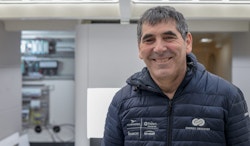High-tech plumbing for Energy Observer
Energy Observer takes care of the details. The experimental catamaran optimizes all its systems to improve its performance as well as the crew’s comfort. Explanations by Roland Reynaud, the on-board engineer.

As the cornerstone of the energy model of tomorrow, hydrogen is the heart of the Energy Observer project. It’s this tiny atom, as common as it is invaluable, which takes over the entire energy production chain when the other renewable energy sources, solar and wind, have given up. The implementation of this innovative technology requires experience and an overall vision of the systems to optimise and share the flows, calories, and therefore the energy produced as well as that consumed.
Two engineers keep a daily watch over the entire on-board hydrogen circuit, and are taking advantage of this winter revision to improve the system and gain a few points of productivity.
“We are currently in the process of modifying all the hydrogen circuits. As it happens, this is convenient since the installation of the two new wings requires us to move the hydrogen vents and chimneys. We will also take advantage to remake the ‘gas plates’ which were exposed to sea spray.”

Roland Reynaud
These optimizations also include a close analysis of the circuits.
“We have again identified areas for improvement. We’re going to eliminate as many “elbows” as possible where water is stagnating, from condensation for example, which inhibits the free flow of hydrogen and causes a loss of charge.”
As with any prototype, Energy Observer evolves as the project progresses. Some pipe-welders, specialists in assembling stainless steel and guided by the engineers, came aboard and welded 150 metres of steel tubing for an optimised hydrogen circuit.
Blending the cultures of ocean races and gas engineering, the famous “gas plates” that receive a lot of equipment have left behind stainless steel alloy for the “composite” that is much lighter and better adapted to this hostile environment.
“Recovering each calorie”
Other file: the thermal efficiency of the fuel cell. The battery produces electricity, but also heat when it operates. Up to now, the emphasis had been placed on the electro-chemical aspect, with the thermal part being partly neglected by the specialist’s own admission.
“A cell is 50% electric and 50% thermal. Up to now, we were content with heating the hot-water tank of the vessel and the nacelle. We began with the assumption that we had “too much” energy when the fuel cell was working, and not enough when it was off.”
Knowing that at the output of the fuel cell’s heat exchangers, the thermometer shows 70 ºC for a flow of about 20 l/min, we can heat a 500 litre water tank when the fuel cell is working. Once the fuel cell has stopped, this water will be used to heat the mechanisms requiring heat to start up, but also the inside of the vessel while supplying the catamaran’s electrical equipment. The heat produced by the electrolyzer and that produced by the electric motors will also be recovered.
Here again, all the composite circuits have been revamped.
“We are trying to recover each calorie, points out Roland Reynaud. In the “hot water” circuit, that represents approximately 20 kWh. “
Calories which will be very valuable for the crew which sets sail to Northern Europe next month…